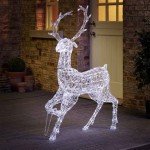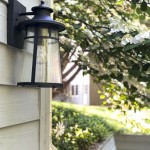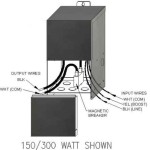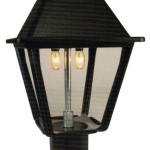```html
Install New Outdoor Flood Light: A Comprehensive Guide
Enhancing the security and aesthetics of a property often involves improving outdoor lighting. Flood lights, in particular, are a popular choice for illuminating large areas, deterring intruders, and providing visibility during nighttime activities. This article offers a detailed guide to installing a new outdoor flood light, covering safety precautions, necessary tools, installation steps, and troubleshooting tips.
Planning and Preparation: Essential First Steps
Before commencing the installation process, careful planning and preparation are crucial. This stage involves assessing the location, selecting the appropriate flood light, gathering necessary tools and materials, and ensuring electrical safety.
Location Assessment: The first step involves determining the optimal location for the flood light. Consider the area that needs illumination. Commonly chosen areas include driveways, backyards, entrances, and garages. Ensure that the chosen location offers a clear, unobstructed view. Furthermore, assess the accessibility of the location for wiring and mounting purposes. Avoid locations where the light might shine directly into neighboring properties or create glare for drivers on nearby roads. Check local ordinances regarding outdoor lighting regulations. Some municipalities have restrictions on light intensity, direction, and operating hours.
Flood Light Selection: Selecting the right type of flood light is essential for achieving the desired outcome. Several factors influence this decision, including the desired brightness, energy efficiency, and aesthetic appeal. Light-emitting diode (LED) flood lights are increasingly popular due to their energy efficiency, long lifespan, and instant-on capabilities. Halogen flood lights, while less energy-efficient, offer a brighter light output at a lower initial cost. Consider the light's lumen output, which measures the total amount of visible light emitted. A higher lumen output indicates a brighter light. Choose a color temperature that matches the intended use and ambiance. Warmer color temperatures (e.g., 2700K to 3000K) provide a soft, inviting light, while cooler color temperatures (e.g., 4000K to 5000K) offer a brighter, more focused light. Ensure the flood light is rated for outdoor use and is weatherproof or waterproof, depending on the exposure to the elements.
Gathering Tools and Materials: Having the right tools and materials readily available streamlines the installation process and ensures a safe and professional outcome. Essential tools include:
- Safety Glasses: To protect eyes from debris.
- Gloves: To protect hands and improve grip.
- Voltage Tester: To verify that power is off before working on electrical circuits.
- Screwdrivers (Phillips and Flathead): For tightening and loosening screws.
- Wire Strippers: For safely removing insulation from wires.
- Wire Connectors (Wire Nuts): For securely joining wires.
- Electrical Tape: For insulating wire connections.
- Drill and Drill Bits: For creating mounting holes.
- Ladder: For reaching elevated locations.
- Level: For ensuring the flood light is mounted straight.
- Pencil: For marking drilling locations.
- New Outdoor Flood Light Fixture
- Mounting Hardware (Screws, Bolts, Washers) - often included with the fixture
- Weatherproof Junction Box (if replacing an existing fixture)
- Weatherproof Sealant (silicone caulk)
- Wiring (if extending existing wiring)
- Conduit Fittings (if running wires in conduit)
Electrical Safety: Electrical safety is paramount during any electrical work. Before commencing any work, turn off the power to the circuit at the main electrical panel (breaker box). Use a voltage tester to confirm that the power is off before touching any wires. Never work on electrical circuits in wet conditions. If unsure about any aspect of the electrical work, consult a qualified electrician.
Installation Procedure: Step-by-Step Instructions
The installation procedure varies depending on whether the flood light is replacing an existing fixture or being installed in a new location. The following steps provide a general guideline, but it's crucial to refer to the manufacturer's instructions for the specific flood light model.
Removing an Existing Fixture (If Applicable): If replacing an existing flood light, begin by carefully removing the old fixture. Ensure the power is turned off at the breaker box. Remove the cover of the existing junction box and disconnect the wires. Typically, there will be three wires: a black (hot) wire, a white (neutral) wire, and a green or bare copper (ground) wire. Use a voltage tester to confirm the power is off. Carefully unscrew the mounting screws and detach the old fixture. Clean the junction box and inspect it for any damage.
Installing a New Junction Box (If Necessary): If installing a flood light in a new location, a junction box is required to house the wiring connections safely. Choose a weatherproof junction box suitable for outdoor use. Mount the junction box to a solid surface, such as a wall or eave, using appropriate screws or bolts. Ensure the junction box is securely attached. Run the electrical wiring to the junction box, either directly or through conduit, depending on local building codes and personal preference. Conduit provides added protection for the wiring.
Wiring the Flood Light: Once the junction box is in place, connect the flood light's wires to the corresponding wires in the junction box. Use wire connectors (wire nuts) to securely join the wires. Connect the black (hot) wire from the flood light to the black (hot) wire in the junction box. Connect the white (neutral) wire from the flood light to the white (neutral) wire in the junction box. Connect the green or bare copper (ground) wire from the flood light to the green or bare copper (ground) wire in the junction box. Ensure the wire connections are tight and secure. Wrap each wire connection with electrical tape for added insulation and protection.
Mounting the Flood Light: Attach the flood light to the junction box using the mounting hardware provided. Ensure the flood light is securely mounted and properly aligned. Use a level to verify that the flood light is mounted straight. Tighten the mounting screws securely. If necessary, use a weatherproof sealant (silicone caulk) to seal around the edges of the flood light to prevent water from entering the junction box.
Testing the Flood Light: After installing the flood light, turn the power back on at the breaker box. Test the flood light to ensure it is working properly. Adjust the angle and direction of the flood light to achieve the desired illumination. Check for any loose connections or other issues. If the flood light does not work, turn the power off and re-check all wiring connections.
Troubleshooting Common Issues
Even with careful planning and execution, some issues may arise during or after the installation process. The following troubleshooting tips can help resolve common problems.
Flood Light Not Working: If the flood light does not turn on, the first step is to verify that the power switch is in the "on" position and that the circuit breaker has not tripped. If the breaker has tripped, reset it. If the breaker trips again immediately, there may be a short circuit in the wiring. Turn off the power and inspect the wiring for any damaged or loose connections. Use a voltage tester to confirm that power is reaching the flood light. If power is present, the bulb or the flood light fixture itself may be faulty. Replace the bulb or the fixture as needed.
Flood Light Flickering: Flickering can be caused by several factors, including a loose connection, a faulty bulb, or voltage fluctuations. Check all wiring connections to ensure they are tight and secure. Replace the bulb with a new one of the correct wattage and type. Contact the local utility company to inquire about voltage fluctuations if flickering persists.
Water Leaking into the Junction Box: Water intrusion can damage electrical components and create a safety hazard. Ensure the junction box is properly sealed and weatherproof. Apply weatherproof sealant (silicone caulk) around the edges of the flood light and the junction box to prevent water from entering. Inspect the wiring for any signs of corrosion or damage. Replace any damaged wiring or components.
Flood Light Aimed Incorrectly: Adjust the angle and direction of the flood light to achieve the desired illumination. Loosen the mounting screws slightly and reposition the flood light. Ensure the beam is not shining directly into neighboring properties or creating glare for drivers. Tighten the mounting screws securely once the flood light is properly aimed.
Photocell Malfunction (If Applicable): Some flood lights incorporate a photocell that automatically turns the light on at dusk and off at dawn. If the photocell is not functioning correctly, the flood light may stay on during the day or not turn on at night. Ensure the photocell is not obstructed by any objects. Clean the photocell lens with a soft cloth. If the photocell continues to malfunction, it may need to be replaced.
By following these steps and taking necessary safety precautions, installing a new outdoor flood light can be a straightforward and rewarding project, enhancing both the security and aesthetics of the property.
```
How To Install A Flood Light The Home Depot

How To Install Outdoor Floodlights True Value

How To Install Outdoor Floodlights

How To Install Flood Lights Light Installation

How To Install Floodlights Safe Watertight And Properly Grounded

Step By Flood Light Installation Guide

How To Wire An Outdoor Flood Light Doityourself Com

How To Install Additional Wiring Add An Outdoor Floodlight

How To Install A Flood Light The Home Depot

Cost To Install Exterior Lights In 2024 Checkatrade







